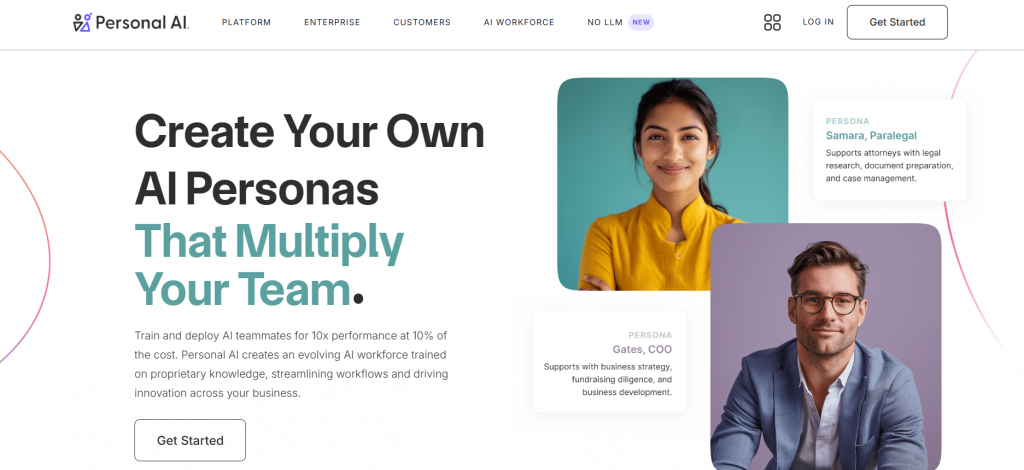Imagine having a perfect digital copy of your memory, an AI that knows what you know, remembers what you forget, and can even help you communicate in your own unique style. This is the promise of platforms like Personal.ai. It’s a powerful concept that gives you a “digital twin” of your mind.
But how do you interact with it? Traditionally, it’s through typing. Now, imagine a more natural way: what if you could simply talk to it? This is where a transformative technology comes in: VoIP Calling API Integration for Personal.ai.
This integration elevates the entire user experience, moving your personal AI from a silent database of your thoughts into a truly interactive, conversational partner. This guide will explore how adding a voice channel doesn’t just add a feature, it fundamentally changes how you capture, recall, and utilize your own digital memory.
Table of contents
What is Personal.ai?
Personal.ai is a unique platform that helps you build a personal artificial intelligence based on your own data. By feeding it your notes, documents, messages, and other personal content, you create a “Memory Stack.” Your AI learns from this data to understand your knowledge and communication style. It can help you recall information, draft messages in your voice, and overcome creative blocks by tapping into your own history of thoughts and ideas.

It’s an incredibly powerful tool for knowledge management and personal productivity. However, the primary method of interaction is text, which can be a significant limitation.
Also Read: How Do Developers Use VoIP Calling API Integration for Play AI?
How Does a VoIP API Fundamentally Improves the User Experience?
A VoIP (Voice over Internet Protocol) Calling API is a service that allows software to make and receive phone calls. When integrated with Personal.ai, it acts as the bridge between your spoken words and your digital mind. Here’s how this directly enhances the user experience.
Effortless, Hands-Free Memory Capture
This is the most immediate and powerful benefit. With a dedicated phone number for your AI, you can call it anytime, anywhere, and simply speak your thoughts.
- Capture Fleeting Ideas: Had a brilliant idea while on a run? Call your AI and describe it.
- Create Voice Memos: Dictate notes, meeting summaries, or daily reflections directly into your Memory Stack.
- Reduce Friction to Zero: You no longer need to find a device, open an app, and start typing. You just call and talk.
This workflow makes capturing information as easy as talking to a friend, ensuring no thought gets lost.
Also Read: How Does VoIP Calling API Integration for LangChain AutoGen Microsoft Works?
Natural, Conversational Recall
Instead of typing a search query, you can have a real conversation with your memory. A VoIP Calling API Integration for Personal.ai allows you to call your AI and ask questions like:
- “What were the key points I noted down about the Apollo project last month?”
- “Remind me of my partner’s favorite restaurant that I mentioned a while back.”
The AI can then retrieve the information from your Memory Stack and respond with a spoken answer, making the process of recall feel like a natural conversation.
A More Accessible Personal AI
Voice makes technology more accessible. For users who find typing difficult, slow, or are visually impaired, a voice-first interface is not just a convenience; it’s an essential feature. This integration ensures that the power of a personal AI is available to everyone, regardless of their ability to use a keyboard.
The technical magic behind this experience is a high-speed conversational loop: you speak, the audio is transcribed to text, Personal.ai processes it, generates a text response, which is then converted back to audio and streamed to you, all in an instant.
Also Read: Building Smarter Apps with VoIP Calling API Integration for Pipecat AI
Conclusion
Personal.ai offers a glimpse into the future of personalized knowledge management. However, to make it truly personal and seamlessly integrated into our daily lives, it needs to communicate like we do, through voice.
The VoIP Calling API Integration for Personal.ai provides this missing link. It breaks down the barrier between thought and digital capture, making the experience more fluid, natural, and accessible.
By leveraging a dedicated voice infrastructure, you can transform your personal AI from a silent archive into a dynamic, conversational extension of your own mind.
Also Read: VoIP Phone Service: How It Works & Best Options for Businesses
Frequently Asked Questions (FAQs)
Yes. VoIP Calling APIs allow you to provision a dedicated phone number for your application, which you can use to call your AI anytime, just like calling a contact.
Security is crucial. The voice infrastructure provider is responsible for securely transporting the audio data. It’s important to ensure they, along with your chosen STT and the Personal.ai platform, have robust security and privacy policies in place.
Low latency is the single most important factor. The delay between when you stop speaking and your AI starts responding needs to be minimal for the conversation to feel natural and not robotic.
This depends on the Text-to-Speech (TTS) technology you choose to integrate. With advancements in voice cloning from leading TTS providers, it is becoming increasingly possible to create a custom voice that matches your own.
